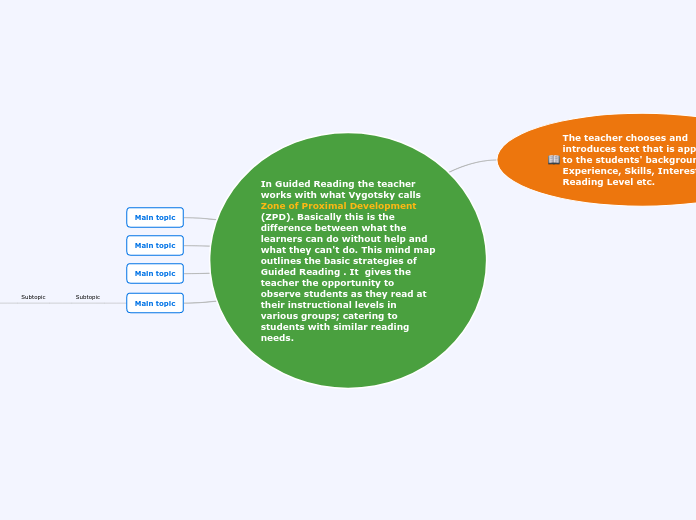In Guided Reading the teacher works with what Vygotsky calls Zone of Proximal Development (ZPD). Basically this is the difference between what the learners can do without help and what they can't do. This mind map outlines the basic strategies of Guided Reading . It gives the teacher the opportunity to observe students as they read at their instructional levels in various groups; catering to students with similar reading needs.
The teacher chooses and introduces text that is appropriate to the students' background Experience, Skills, Interest, Reading Level etc.
Place the students in groups. No more than 6 students per group so that the teacher can provide the support that each student needs. Everyone in the group has the same text and similar needs. The text must be moderately challenging--not frustrating to the reader.
Remind students of strategies they might use to construct meaning. Encourage them to use highlighters or sticky notes to remember anything that was challenging or something that they didn't understand. While reading they can request help if needed, and think actively to comprehend the text. The students analyze words to make sense of them, use prior knowledge and experience to construct meaning.
Having previously modeled the habits of the proficient reader, the teacher now moves around the groups-- listening to students read. The teacher may asks his or herself the question: Are the students using the previously taught reading strategies? As she circulates the groups she asks questions that encourage higher level thinking skills and engage students in conversations about the text they're reading. Groups must be flexible so that students can move into different groups as they progress in their reading goals.
Teacher gathers assessment notes for students' feed-back and "feed -forward". Assessment notes can also be used for teacher-reflection: "Did I achieve the goal of the lesson?" "Were the curriculum objective(s) achieved?"
Culminating activities may include: Talking about the text: (1) text-to-text, text-to-self, text- to-world (2) role-play a character (3) act out a scene (4) develop a graphic organizer (5) write a personal response or (6) 3-2-1 response to the text.
Main topic
Main topic
Main topic
Main topic
Subtopic
Subtopic
Subtopic
